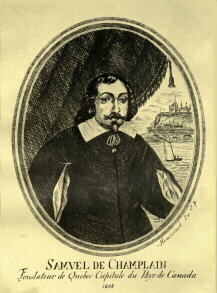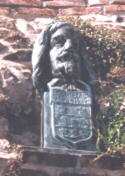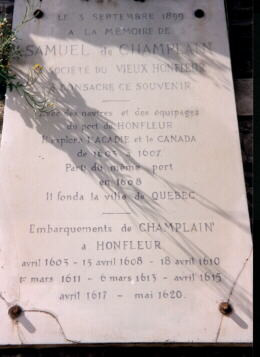 |
The advent of this new century recalls the discovery of America, the beginnings of New-France and the foundation of Quebec by Champlain, four hundred years earlier. Already, on both sides of the borders, they are planning festivals to celebrate Champlain between 2003 and 2009.
Who was Champlain, the founder of Quebec? |
Biography
Samuel de Champlain 1570-1635 - Maréchal de Logis, Navigator, Geographer and Cartographer, founder of Port-Royal and of Quebec and Father of New-France Born in Brouages [France] in 1570, son of Antoine Champlain, Nobleman and Captain of the Navy; and Marguerite LeRoy. He accomplished his first voyage in America in 1599. In 1603 he was named Royal Geographer by [King] Henri IV. He discovered Massachusetts Bay and Boston in 1605, founded Quebec in 1608 and explores Lake Champlain in 1609. At the age forty years, he married in the church of Saint-Germain of Auxerre in Paris, Helene Boullé, daughter of Nicolas Boullé, Secretary of the Kings Chamber, and Marguerite Alix. The ceremony took place on December 3, 1610. After his many establishments, voyages and discoveries, he returned to France. The king renewed his Lieutenancy to him, accomplishing his twelfth and last voyage. He appeared at Quebec on May 23, 1633 and finds the colony almost abandoned. Taking up his work again, he builds a Chapel to Notre Dame de Recouvrance. In October 1635, he bequeaths his belongings to Notre Dame. Struck by paralysis, he died on December 25, 1635, Christmas Day, to be buried near the Chapel. His tomb has not been found again, but the archaeologist Rene Lévesque, in the research of the burial of Champlain for a number of years; believes he is at the dawn of discovering of the tomb of the founder of Quebec.
Works of Champlain
In 1870, the abbot Charles-Honore Laverdière (1826-1873), historian and librarian of Laval University has published under the patronage of the university, the works of Champlain which up to that point were not accessible to the public because of the rarity of the first editions from France. The first edition does not exist any more. Printed in Ottawa by George E. Desbarats, it was destroyed by fire at the time of the printing. A preserved proof allowed the draft of the second edition in 1870 under the direction of the Abbot Laverdière of the Seminary of Quebec. Mgr Auguste Gosselin stated before the Royal Society of Canada that the works published by Laverdière are a monument erected to the memory of Champlain. The collection, preserved at the Institute Canado-American in Manchester, New Hampshire, comprises four large volumes, which join together the five volumes, whose titles are as follows:
Volume I: "Short speech of the remarkable things that Samuel Champlain of Brouage recognized in the Western Indies. For the trip that he made in the years 1599 and 1601."
Volume II: "Of the Savages or travels that Samuel Champlain made in New France, the year 1603 containing manners, way of living, wars and dwellings of the Savages of Canada. Of the discovery of more than 450 leagues in the country of the Savages. Of the people living there; the animals that are found there: the rivers, lakes, isles and lands, and what trees and fruits they produced. Of the coast of Acadie, the lands that have been discovered there, and several mines which are there, according to the accounts of the Savages.
Volume III: "The travels of the Sieur de Champlain, of Xaintonge, Ordinary Captain for the King in the Navy. Divided into two books or very faithful journals of the observations and discoveries made from New France; much in the description of the lands, coasts, rivers, ports, harbors, their heights and many variations of the magnetic declinations: that in the credence of the people, their superstitions, way of living and of war making; enriched with a quantity of figures. 1613."
Volume IV: "Voyages and discoveries made in New-France since the year 1615 until the end of the year 1618 by Sieur de Champlain, Ordinary Captain for the King in the Sea of the West. 1619."
Volume V: "The Travels of Western New France, called Canada made by the Sieur de Champlain, of Xaintonge, Captain for the King in the Navy, of the West and all the discoveries which he made in this country from the year 1603 until the year 1629. Feature of the Navy and the Duty of a Good Sailor by the Sieur de Champlain."
Monuments of Champlain
 |
The name of Champlain is fixed in many sites and places, lakes, cities, villages, counties, streets, schools, and clubs both in Canada and in the United States. Many monuments and plaques were erected to his memory. Here a list which is not exhaustive: |
1. Monument of Champlain at Quebec - the most imposing - erected on the Dufferin Terrace opposite the river. Inaugurated on September 21, 1898 by Lord Aberdeen, Governor General of Canada. The work of Monsieurs Chevré and Cardonnal of Paris.
2. Monument of Champlain in Champlain, State of New York - erected in 1907 near the Saint Mary Church in the center of the village.
3. Monument of Champlain at Isle La Motte, State of Vermont - erected opposite St Anne's Shrine, in the park on the shore of the lake Champlain. This monument was moved from the Expo 67 site in Montreal to Isle La Motte.
4. Monument of Champlain at Plattsburg, State of New York - erected in Trinity Park near the Plattsburg Town Hall.
5. Monument of Champlain at Crown Point, State of New York - erected in 1912 by the States of Vermont and New York, this monument recalls the discovery of the magnificent Lake Champlain.
6. Monument of Champlain at Ottawa - at Point Nepean.
7. Monument of Champlain at Orillia in Ontario - an imposing monument.
8. Monument of Champlain at St John in New Brunswick - erected in the Queens park.
9. Dwelling of Champlain at Lower Granville in Nova-Scotia - built on the site of Port-Royal and reconstituted at the same place.
10. Glass in the Canadian Parliament Building at Ottawa - installed near to the office of the Governor General - reproducing the departure of Champlain from Honfleur in April 1608.
11. Cairn at Corbeil in Ontario - installed on the main road close to Lake Nipissing - it recalls the passage of Champlain on July 26, 1615.
12. Plaque in Bangor, State of Maine - erected in Kenduskeag Park carrying this inscription: "Near this spot in the year 1604, Samuel de Champlain gallant pioneer and intrepid explorer made a landing on the voyage up the Penobscot River."
13. Plaque in Seal Harbor, State of Maine - erected in Deserted Mount Island, emphasizing the passage of Champlain on September 5, 1604.
14. Plaque at Stage Harbor - Chatham - Cod Cape, State of Massachusetts - erected by professor Carol Wight of the University of John Hopkins to commemorate the passage of Champlain in October 1606. Plaque in Rockford, State of Massachusetts - erected in 1930 on Route 127 by Massachusetts Bay Colony Tercentenary Commission.
15. Plaque at Boston, State of Massachusetts - bronze plaque erected at door 16 of the Logan International Airport on July 15, 1955 by the Franco-American Historical Society to mark the discovery of the Port of Boston by Champlain on July 16, 1605, called by Champlain "Baye of Isles".
16. Champlain Street with Saint-Jean-sur-Richelieu - named on April 7, 1873, this street extends in the south-north direction between the streets Frontenac and Jean-Talon; it borders the Richelieu River and the Chambly Canal between Saint-Paul Street and the Saint-Luc Boulevard.
|
Expedition of Champlain on the Richelieu River - Itinerary of the Expedition of 1609 Going Return |
The Voyages of Champlain
 |
The activities of Champlain on the American continent were numerous. Father Lejeune, OMI, drew up a list of the voyages of Champlain from France to America which was supplemented by the text of a commemorative plaque that the traveller and the lover of the history can read on a wall of the Port of Honfleur: |
| 1599-1601 | From Cadiz [Spain] to Panama |
| April 1603 | From Honfleur to Montreal |
| 1604-1607 | From Honfleur to Port-Royal |
| April 13, 1608 - 1609 | From Honfleur to Quebec |
| April 8, 1610 | From Honfleur to Richelieu |
| March 1, 1611 | From Honfleur to St Louis Falls |
| March 6, 1613 | From Honfleur to Allumettes |
| April 1615-1616 | From Honfleur to Lake Huron |
| April 1617 | From Honfleur to Three Rivers |
| May 1620-1624 | From Honfleur to Quebec |
| 1626-1629 | From Dieppe to Quebec |
| July 4, 1632 | From St Anne d'Auray to Port- Royal on the ship "The Hope in God" |
| 1633-1635 | From Dieppe to Quebec |
 |
The Order of Good Times
Remote origins:
This order was instituted by Samuel de Champlain to distract or entertain the men of his crew during the long winter months that they were going to pass at Port-Royal, Acadie
* The Order was comprised of a variable number people or groups of people that common goals joined together.- - The members of the Order ate at the table of Poutrincourt, the Intendant of the King.
* They were sympathetic people who had importance in the new colony.
* The demonstrations comprised a French gastronomy, the music of the time and costumes, if possible.
* This Order emphasized arts and popular traditions of French origin. His history in the land of America:
* November 14, 1606 is the date of foundation of "The Order of Good Times", while Champlain represented Louis XIII, King of France, with Port-Royal, Acadie.- In 1608, Champlain descended the river in a boat and posed the foundations of New-France in what became Quebec, where they pursued the activities of the "The Order of Good Times"
* The following year, in 1609, Champlain followed the River of the Iroquois and went to this stretch of water, this "inland sea", which he named Lake Champlain.- About 1632, in expedition towards the exploration of the Large Lakes, he gave to the river the name of Richelieu, name of the Cardinal-Minister of Louis XIII, King of France.
* It is to the Sun King himself, Louis XIV of France, who returned the decision to construct along the banks of this Richelieu river the forts which will ensure the protection of the citizens, land clearers and fur sellers: Chambly, St Jean and St Therese.
* 1666 was the year of founding of Fort St Jean; a French garrison was placed there permanently; the Carignan Regiment settled there, directed by Commandant de Léry, and "The Order of Good Times" continued their activities remaining for the garrison in place.
* With the wars, separations and the lapse of memory of time, the Order disappeared in New-France. In 1936, Father Ambroise Lafortune, well-known of the world of arts of Montreal, started again the popular traditions of "The Order of Good Times".
* 2002: 336 years of uninterrupted military presence on the site of Fort St-Jean, which today is called the "Campus of Fort St Jean", that MUST be celebrated! We thus launch the "The Order of Good Times". Official statement of Florent Tremblay, professor, royal military ex-College of St Jean.